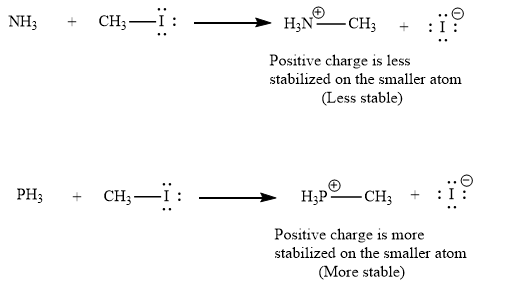
(a)
Interpretation:
It is to be predicted which of the two nucleophiles in the given pair will react faster with
Concept introduction:
The minimum amount of energy required by reacting molecules to reach the transition state is called the activation energy.
For nucleophilic substitution reactions, if the reactant is the same, the activation energy increases with increasing stability of the substitution product.
The reaction is faster when the energy barrier between the reactants and products is small. When energy difference between reactants and the transition state is smaller than the energy difference between products and transition state, the reactants are highly reactive and reaction is faster. Highly reactive reactant molecules serve as strong nucleophiles. The reactants are less reactive and the reaction slower, when the transition state is closer in energy to the products than the reactants.
Answer to Problem 9.4P
(i) Among the two nucleophiles, the nucleophile
(ii) Among the two nucleophiles, the nucleophile
Explanation of Solution
(i) The first given pair of nucleophiles is
The reactions of each of these nucleophiles with

There is a significant difference in charge stability on the reactant side but not on the product side because the negative charge in
(ii) The second given pair of nucleophiles is
The reactions of each of these nucleophiles with

There is a significant difference in charge stability on the product side but not on the reactant side. Because a positive charge is more stable on phosphorous atom than on nitrogen atom, the product of the nucleophilic substitution involving
Therefore, the energy barrier involving
As nucleophilicity of the attacking species increases in
(b)
Interpretation:
It is to be determined which of the given pairs is the stronger nucleophile.
Concept introduction:
The minimum amount of energy required by reacting molecules to reach the transition state is called the activation energy. For nucleophilic substitution reactions, if the reactant is the same, the activation energy increases with increasing stability of the substitution product. When energy difference between reactants and the transition state is smaller than the energy difference between products and transition state, the reactants are highly reactive and reaction is faster. Highly reactive reactant molecules serves as strong nucleophiles.
Answer to Problem 9.4P
(i) Among the pair of nucleophiles,
(ii) Among the two nucleophiles,
Explanation of Solution
(i) The first given pair of nucleophiles is
In part (a), it is determined that the reaction of
(ii) The first given pair of nucleophiles is
In part (a), it is determined that the reaction of
Among the two given nucleophiles, the stronger nucleophile is the one that exhibits a faster reaction.
Want to see more full solutions like this?
Chapter 9 Solutions
ORG.CHEM W/TEXT+SOLU.MANUAL
- For the reaction given below, draw a mechanism (curved arrows) and then predict which side of the reaction is favoured under equilibrium conditions.arrow_forwardDraw the correct curved arrow mechanism for the reaction shown below? Make sure to include positive and negative charges.arrow_forwardFrom the curved arrows drawn, determine the products of each of the following reactions.arrow_forward
- Draw a curved arrow mechanism for the substitution reaction that will occur with the alkyl halide and nucleophile below, adding steps as necessary. Be sure to include all nonbonding electrons and all nonzero formal charges, and show all species that react or are formed in this reaction.arrow_forwardDraw a mechanism for the reaction of the ketone with hydronium ion. In the first box, draw any necessary curved arrows. Show the products of the reaction in the second box. Include any nonzero formal charges and all lone pairs of electrons.arrow_forward. Use to curved arrow notation, propose a mechanism for the following reaction and state whether it is either SN1, E1, SN2, or E2. Give the IUPAC names of all organic reactants and products.arrow_forward
- Provide the complete mechanism for the reaction. Please include appropriate arrows, intermediates, and formal charges.arrow_forwardDraw the complete, detailed E1 mechanism for each of the following reactions, and show all resonance structures, where applicable.arrow_forwardBy following the curved red arrows, draw the product(s) of each of the following reaction steps. Also indicate which species is the electrophile and which is the nucleophile.arrow_forward
 Organic Chemistry: A Guided InquiryChemistryISBN:9780618974122Author:Andrei StraumanisPublisher:Cengage Learning
Organic Chemistry: A Guided InquiryChemistryISBN:9780618974122Author:Andrei StraumanisPublisher:Cengage Learning
